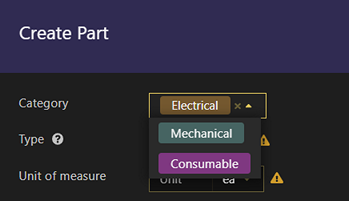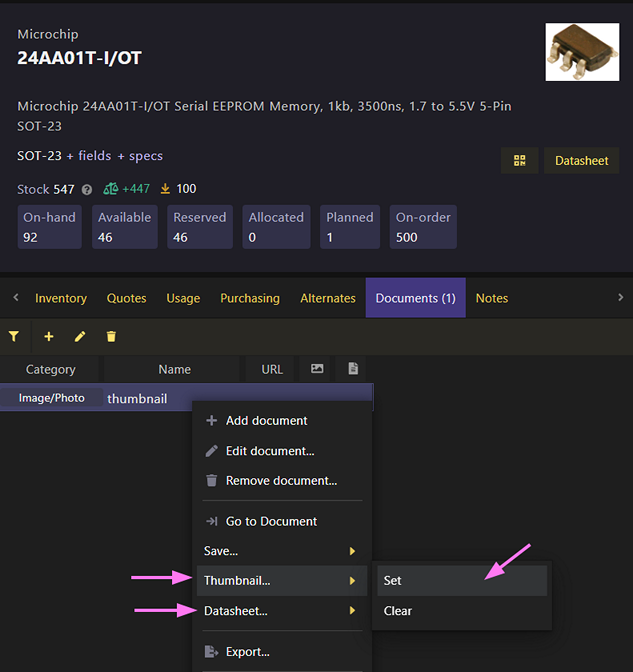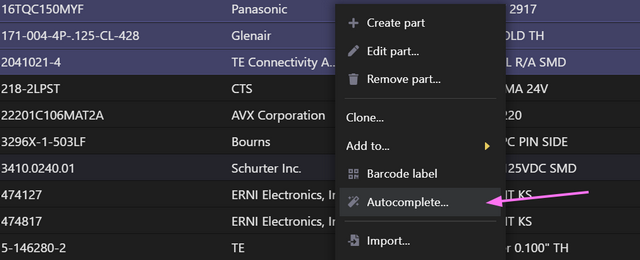Parts
Parts identify the things you want to keep track of. Parts have inventory that can be kept in storage locations.
Categories
There are 4 categories of parts: Electrical, Mechanical, Consumable and Other.

The Other category is simply meant for parts that don't fit in the remaining ones. Equipment and tools might be a good fit for it.
Consumables
Consumables are parts that aren't measured by each piece (such as chips or screws) but length, area, volume or weight (such as wire or glue). Only consumables can have a unit of measure different than Unit.
When quoting consumables, custom quotes must be used. The reason for this is that the APIs the app integrates with don't provide information about the bulk quantity that can be purchased. For example, the APIs might say "each box of screws costs 10 USD" but they don't provide the quantity in each box, which makes it impossible for the app to know the cost per screw (or the cost per mL of glue, or the cost per inch of wire, etc.). This way, custom quotes and price breaks should be manually created, using an appropriate unit of measure.
You might want to create a unit of measure that defines the bulk quantity in which you are able to purchase it (e.g. Box of 10 or 250mL Bottle) while, when consuming these materials, the base unit would be used instead (e.g. each or mL or L).
Types
There are 4 types of parts:
- Outsourced: parts that are sourced from external suppliers.
- In-house: parts that are designed and/or manufactured in-house. In-house parts might have a Product linked to it
- Generic: not a physical part, it represents a group of parts that share the same or similar specifications.
- Asset: everything else that doesn't fit the previous types (e.g. machines or office gear such as computers).
Once a part is created, you cannot change its type.
Mandatory fields
Outsourced parts require both the Part Number and Manufacturer fields to be defined. Once created, these cannot be changed, so the only option to change them would be to create a new part. This is for performance reasons and to ensure the uniqueness of outsourced parts through their part number and manufacturer as, although not very common, two different manufacturers might actually use the same part number.
For other types of parts the only mandatory field is the Type, which, when omitted (when importing parts), it's assumed to be Outsourced. The field Type cannot be changed once the part has been created.
Generic parts
Generic parts aren't physical ones. Instead, they represent, or group, parts that might be used interchangeably. This is specially useful for resistors and capacitors for which you might not be concerned about their manufacturer as long as they have the same or similar specifications.
They can also be used to postpone the decision of which part to use. For example, while creating a BOM you might assign generic parts to some items and only pick a real one by the time you go into production.
The parts that can be used in place of a generic one are defined through its part alternates. When reserving inventory for a production build, you can either replace the generic part for a real one, or to pick inventory from multiple of its alternate parts.
Parts vs products
While Parts allow the app to keep information about the objects you want to keep track of, as well as its inventory, Products allow the app to keep track of its bill of materials (BOM) and production. Only in-house parts can have a Product associated with it.
Unique internal PNs
When Unique internal PNs is enabled, under Settings - Parts, the app checks for duplicates whenever manually creating new parts. At the moment, it doesn't check for duplicates when importing parts through a CSV file.
Additionally, when Unique internal PNs is enable, parts can be identified by their Internal PN whenever importing data (parts, if they exist already, items on a purchase order, or sellables on suppliers).
Labels
Labels are another way to categorize your parts and can be managed through Settings - Workspace - Parts. Labels can be bulk imported through a .TXT file (learn more) or when bulk importing parts.
SI values
The format used in a part's Value field is somewhat strict. It must be composed of a single numeric value and optionally an SI prefix and unit (e.g. 100 nF). This is so that the app is able to match equivalent values, by extracting and comparing their numeric values and units. This way, filtering values by 0.1uF or 100nF yields the same results, as expected.
When filtering data, all SI prefixes and units are case-sensitive except for K, Ohm and Hz.
When searching for resistors, the SI unit (ohm) can be omitted. Similarly, when searching for capacitors with a micro, nano, pico or fento prefix, the unit (F) can also be omitted.
As an example, if you want to search for a 100 Ohm resistor you could type 100, 100 ohm or 100 Ohm. In case you want to search for a 0.1 uF capacitor then you could type 0.1u or 100n.
Ownership
Inventory ownership is not set on the inventory itself but on the Storage location it's stored at. In other words, a storage location might have an owner and all inventory in that location will belong to that owner. Owners are Contacts.
This is mostly important during production as you can tell the app if a Product, in case it also has an owner (which might as well represent a customer in this case), can use inventory only from that owner or not.
Alternate and equivalent parts
Similar parts share the same value and package but they aren't necessarily valid alternates of each other. Other specifications, such as tolerance and dielectric type might tell if it can be used as an alternate part or not. A listing of similar parts is provided by the app for every part but it's up to the user to define valid part alternates.
Two parts are equivalent if both are alternates of each other.
For sale
Parts can be marked for sale and only these will show up as candidates to be added into sales orders and on sales-only suppliers, when adding (sales-only) quotes.
Prices
Unit cost
The Unit cost field represents the value you paid on average for every unit of inventory you have of a part.
Initially, when you create a part, this can be set to an estimated value (if you have it available). For Products, you can estimate a unit cost through the Products > Pricing & Availability table.
The unit cost can be automatically updated in these three situations:
- When manually adjusting inventory
- When receiving items on a purchase order
- When finishing a production build
The unit cost of a generic part is the average of its alternate parts' unit cost.
When automatically updating the unit cost, the app takes into consideration quantities and prices, both the previous and new ones. For example, considering you currently have 1000 pcs of a part with a unit cost of 2 USD per piece, if you add 500 pcs for 3 USD each, the new unit cost would be (1000 × 2 + 500 × 3)/(1000 + 500) = 2.33 USD.
Inventory value report
Knowing the price you paid for you inventory, you can get an inventory value report which includes the current stock and how much it's worth (i.e. the on-hand stock multiplied by the unit cost of each part).

Selling price
The Unit cost refers only to the price you paid, on average, for the inventory you have of a given part.
In case you have parts for sale, you can also define a selling price by either editing the Selling price of the part or creating custom (sales-only) quotes through the Suppliers tab.
The way a selling price is calculated is completely up to you. In other words, the app doesn't provide a way to automatically calculate it. However, for in-house parts the quoting feature might help you on that.
Attrition rate
Attrition rate accounts for inventory losses during production and can be set for each part. A percentage and/or a fixed value might be used and a given quantity with attrition would be calculated as follows:
Qty w/ attrition = Qty + MAX( Qty × percentage / 100 , no-less-than )
As an example:
Attrition rate = 3% and no less than 10 units
Required qty = 1000
Qty w/ attrition = 1030
(percentage is used as 30 is greater than 10)
Required qty = 100
Qty w/ attrition = 110
(fixed value is used as 3 is lower than 10)
Thumbnail and datasheet
For outsourced parts the app will try to fetch a default thumbnail and a datasheet so you don't have to find one on your own. However, in case the app can't find one or you want to override the default one, you can do it by adding a document for the thumbnail and/or datasheet first and then set it as the default one like so:

Data autocompletion
The app can autocomplete outsourced parts' data in two situations:
- When manually creating parts, it will give you suggestions of parts as you type in a
Part Number - Once parts have been created (either manually or after being imported), you can still autocomplete some missing fields
The fields that can be autocompleted, in case that information is available are: Description, Value, Package and Tolerance.
To autocomplete data after parts have been created, right-click on the Parts table and select Autocomplete...
